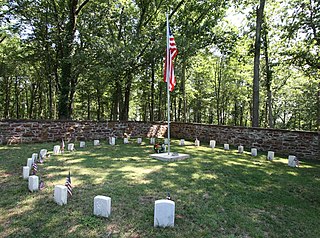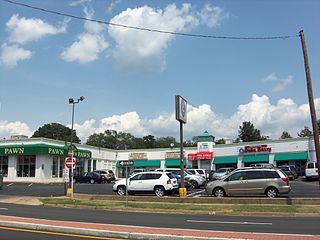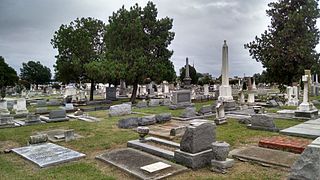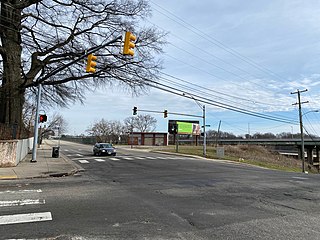Lincoln is a historic unincorporated village in the Loudoun Valley of Loudoun County, Virginia, located approximately 1.5 miles (2.4 km) south of Purcellville. It was established as the community of Goose Creek during the 1750s by Quaker settlers and renamed "Lincoln" for the president of the same name, shortly after his election in 1860.

Buildings, sites, districts, and objects in Virginia listed on the National Register of Historic Places:

Richmond National Cemetery is a United States National Cemetery three miles (4.8 km) east of Richmond in Henrico County, Virginia. Administered by the United States Department of Veterans Affairs, it encompasses 9.7 acres (3.9 ha), and as of 2021 had more than 11,000 interments. It is closed to new interments. Richmond National Cemetery was listed on the National Register of Historic Places in 1995.

Augusta Stone Church is a Presbyterian (PCUSA) place of worship located in Augusta County in the Commonwealth of Virginia, USA in the unincorporated community of Fort Defiance. The church was one of two meeting houses established by The Congregation of the Triple Forks of the Shenandoah in the year 1740. Augusta Stone and sister meeting house Tinkling Spring were both served by the Rev. John Craig. The final structure which was completed in 1749 is still in use and holds the distinction of being the oldest Presbyterian Church in continuous use in Virginia.

Swoope is an unincorporated community in Augusta County, Virginia. Swoope is located on State Routes 703 and 860 7.4 miles (11.9 km) west of Staunton. Swoope has a post office with ZIP code 24479, which opened on March 6, 1838. Polyface Farm, a sustainable farm run by Joel Salatin, is also near Swoope. Students in the area go to Beverley Manor Elementary School, Churchville Elementary School, attend Beverley Manor Middle School, and Buffalo Gap High School.

The Hebrew Cemetery in Richmond, Virginia, also known as Hebrew Burying Ground, dates from 1816. This Jewish cemetery, one of the oldest in the United States, was founded in 1816 as successor to the Franklin Street Burial Grounds of 1789. Among those interred here is Josephine Cohen Joel, who was well known in the early 20th century as the founder of Richmond Art Co. Within Hebrew Cemetery is a plot known as the Soldier's Section. It contains the graves of 30 Jewish Confederate soldiers who died in or near Richmond. It is one of only two Jewish military cemeteries outside of the State of Israel.

Ball's Bluff Battlefield Regional Park and National Cemetery is a battlefield area and a United States National Cemetery, located 2 miles (3.2 km) northeast of Leesburg, Virginia. The cemetery is the third smallest national cemetery in the United States. Fifty-four Union Army dead from the Battle of Ball's Bluff are interred in 25 graves in the half-acre plot; the identity of all of the interred except for one, James Allen of the 15th Massachusetts, are unknown. Monuments to fallen Confederate Sergeant Clinton Hatcher and Union brigade commander Edward Dickinson Baker are located next to the cemetery, though neither is buried there. While the stone wall-enclosed cemetery itself is managed through the Culpeper National Cemetery and owned by the Department of Veterans Affairs, the balance of the 223-acre (0.90 km2) park is managed through the Northern Virginia Regional Park Authority.

Cole's Hill is a National Historic Landmark containing the first cemetery used by the Mayflower Pilgrims in Plymouth, Massachusetts in 1620. The hill is located on Carver Street near the foot of Leyden Street and across the street from Plymouth Rock. Owned since 1820 by the preservationist Pilgrim Society, it is now a public park.

The Glebe House, built in 1854–1857, is a historic house with an octagon-shaped wing in Arlington County, Virginia. The Northern Virginia Conservation Trust holds a conservation easement to help protect and preserve it. The name of the house comes from the property's history as a glebe, an area of land within an ecclesiastical parish used to support a parish priest. In this case, the glebe was established by the Church of England before the American Revolutionary War.

The Shockoe Hill Cemetery is a historic cemetery located on Shockoe Hill in Richmond, Virginia.

Hope Cemetery is an historic rural cemetery at 119 Webster Street in Worcester, Massachusetts. Established in 1854, it was the city's sixth public cemetery, and is the burial site of remains originally interred at its first five cemeteries. Its landscaping and funerary art are examplars of the rural cemetery movement, and the cemetery was listed on the National Register of Historic Places in 1997. The cemetery occupies 168 acres (68 ha).

The Gideon Putnam Burying Ground is located on South Franklin Street in Saratoga Springs, New York, United States. It contains over 150 graves of early and mid-19th century residents of the city, all from the period between 1812 and 1871. It was restored in the 1980s after suffering from almost a century of neglect.

The Revolutionary War Cemetery, also called the Old Salem Burying Ground, is located on Archibald Street, just off state highway NY 22 in the village of Salem, New York, United States. It is a 2.6-acre (1.1 ha) area with over a thousand graves, at least 100 of which are those of Revolutionary War dead or veterans.

The Sharp Burial Ground, also known as the Albany Avenue Cemetery, is located on Albany Avenue in Kingston, New York, United States. It is a small burying ground used during the middle decades of the 19th century, before larger rural cemeteries had become common but after churchyards had become too full for further burials. Later, when they did open, many bodies were removed to consolidate them with larger family plots there. Two former congressmen are still among those buried at Sharp.

Old Providence Stone Church is a historic church in Spottswood, Virginia in Augusta County, Virginia.

Brooke Cemetery is a historic rural cemetery located at Wellsburg, Brooke County, West Virginia. It was founded in 1857. It includes several notable examples of funerary art in its headstones, above ground crypts, and mausolea dating to the 19th and early 20th century. It was designed by John Chislett, who also designed Allegheny Cemetery in Pittsburgh, Pennsylvania.

Glebe Center, also known as Glebe Shopping Center, is a historic shopping center located in the Ballston neighborhood of Arlington County, Virginia. It was designed by noted Washington, D.C. architect Mihran Mesrobian and built in 1940. It is a one-story, "L"-shaped cinder-block building with a flat parapet roof and clad in a six-course, American-bond brick veneer with cast-stone decorative accents. It features large store-front windows, Art Deco decorative elements, and a central square tower surmounted by a glass-block clerestory capped by a pyramidal-shaped metal roof. It was built to serve the residents of the Buckingham apartment complex and Ashton Heights, as well as the many motorists traveling along Arlington Boulevard and North Glebe Road.

Glebe Schoolhouse is a historic one-room school building located near Summerdean, Augusta County, Virginia. It was built in 1830, as a one-room, brick schoolhouse with a gable roof and gable-end chimney. It is the only extant one-room school of brick construction, the oldest documented schoolhouse, and one of the few surviving privately built schoolhouses in Virginia. The school closed in the early-20th century, and subsequently converted to a private dwelling.

Cedar Grove Cemetery is a historic public cemetery located at Portsmouth, Virginia. It was established by an act of the Virginia General Assembly in 1832. The cemetery contains more than 400 graves with monuments dating from the late 1700s to the present. Its memorial markers include small tablets, ledger stones, obelisks, columnar monuments and mausoleums. They include notable examples of Greek Revival, Late Victorian, and Exotic Revival funerary art.

The Shockoe Hill African Burying Ground was established by the city of Richmond, Virginia, for the interment of free people of color, and the enslaved. The heart of this now invisible burying ground is located at 1305 N 5th St. It was created as the replacement for the Burial Ground for Negroes, now also called the Shockoe Bottom African Burial Ground,. Shockoe Bottom was known historically as Shockoe Valley. The Burial Ground for Negroes was closed in 1816 upon the opening of this new African Burying Ground on Shockoe Hill. The Shockoe Hill African Burying Ground is one of Virginia's most endangered historic places. Major threats to the burial ground are the DC2RVA high-speed rail project, the east-west Commonwealth Corridor, as well as the proposed widening of I-64, and various infrastructure projects.























